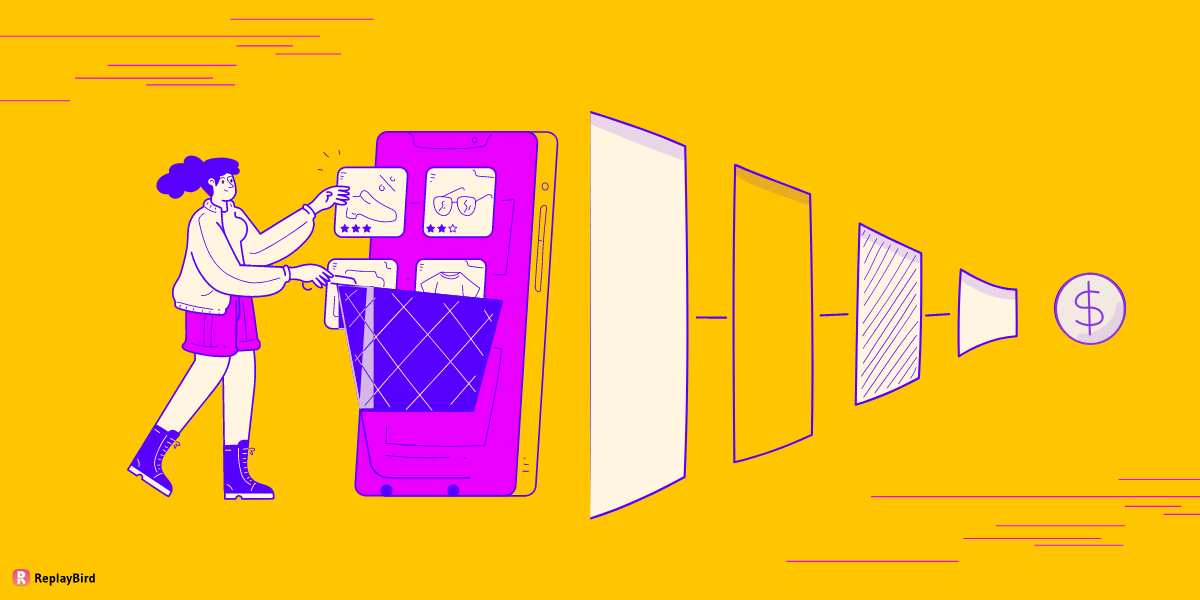The rise of e-commerce has brought about a paradigm shift in the way businesses operate, providing customers with unparalleled convenience in shopping for goods and services online.
However, this convenience has also led to a significant challenge for businesses - cart abandonment.
Cart abandonment occurs when customers add products to their online shopping carts but fail to complete the transaction by checking out, resulting in lost sales and revenue.
In this blog post, we will explore the reasons behind cart abandonment, its impact on businesses, and the best practices that businesses can employ to mitigate cart abandonment rates.
- What is Cart Abandonment?
- Cart Abandonment - Statistics
- Causes of Cart Abandonment
- Solutions to Reduce the Cart Abandonment
- Reduced Cart Abandonment Examples
What is Cart Abandonment?
Cart abandonment refers to the situation where a customer adds items to their online shopping cart but leaves the website without completing the purchase. This can have a significant impact on revenue, making it crucial for businesses to address this issue.
Several factors contribute to cart abandonment, including unexpected shipping costs, complicated checkout processes, distrust of the website, and comparison shopping.
To increase sales and revenue, online businesses must take steps to reduce cart abandonment and improve the shopping experience for their customers.
Why it is important to address cart abandonment?
Reducing cart abandonment is crucial for online businesses because it has a direct impact on their sales and revenue.
When customers abandon their shopping carts, it indicates that they were interested in purchasing the products but decided not to proceed with the transaction.
This can result in lost sales and a negative perception of the business in the minds of the customers.
By addressing cart abandonment, businesses can identify the reasons behind it and implement strategies to reduce it, thereby improving their conversion rates and revenue.
Furthermore, retaining existing customers is more cost-effective than acquiring new ones, making cart abandonment a critical issue to address.
Cart Abandonment - Statistics
#1 Cart Abandonment Rates by Industry
The cart abandonment rate can significantly vary across industries due to the differences in customer behavior and expectations
By analyzing the cart abandonment rates in their industry, businesses can determine the factors that lead to cart abandonment and tailor their solutions accordingly to reduce the impact on their revenue.
This can help businesses develop effective strategies to improve the checkout process and retain customers.
#2 Average Cart Abandonment Rates
the average cart abandonment rate of 69.57%, it is crucial to note that this rate can have a significant impact on the success of an online business. The high abandonment rate also suggests that there may be common underlying issues that contribute to cart abandonment across various industries.
Identifying and addressing these issues can potentially help businesses reduce their cart abandonment rates and increase their sales and revenue.
In addition, the high cart abandonment rate could be a result of customers using their shopping carts as a wishlist or for price comparison across multiple websites.
Therefore, businesses need to provide a positive and seamless shopping experience, from browsing to checkout, to encourage customers to complete their purchases on their website.
Moreover, the statistic on average cart abandonment rates provides valuable insight into the extent of the problem and the potential impact it can have on an online business.
It highlights the need for businesses to focus on improving their checkout process, offering competitive pricing, and providing a positive customer experience to reduce cart abandonment rates and increase their conversion rates.
#3 Impact of Cart Abandonment on Businesses
The average value of abandoned carts per online store is $4,479 per month. This means that businesses are losing out on potential revenue due to cart abandonment.
Furthermore, the same study found that implementing cart abandonment emails can lead to a recovery rate of up to 31%, meaning that businesses can recover a significant portion of lost sales by implementing effective cart abandonment strategies.
Top four reasons for the impact of cart abandonment on businesses:
- Lost sales
- Reduced customer lifetime value
- Increased customer acquisition costs
- Negative impact on brand reputation
#4 Mobile vs. Desktop Abandonment Rates
Mobile vs. Desktop Abandonment Rates refer to the comparison between the cart abandonment rates of mobile and desktop devices. The cart abandonment rate for mobile devices is higher than for desktop devices, with an average of 85.6% for mobile and 73.1% for desktop. This highlights the importance of optimizing websites for mobile devices to reduce abandonment rates.
The higher cart abandonment rates for mobile devices can be attributed to various factors, such as the smaller screen size, slower loading times, and difficulties in inputting information on smaller screens. Therefore, businesses need to ensure that their websites are optimized for mobile devices, with a user-friendly interface, fast loading times, and simple checkout processes.
#5 Cart abandonment recovery
Cart abandonment recovery is a regain sales from customers who left their shopping carts without completing their purchases. This is achieved through different marketing techniques, including abandoned cart emails, retargeting ads, and tailored offers.
The main objective of cart abandonment recovery is to persuade customers who might have been hesitant to finalize their purchases to return and complete them. By reminding them of their abandoned items and presenting them with incentives such as free shipping or discounts, businesses can potentially recover missed sales and boost their revenue.
Causes of Cart Abandonment
#1 Lack of urgency
When customers lack a sense of urgency or a compelling reason to buy, they may abandon their shopping cart and not come back.
To prompt customers to finish their purchase, one can offer time-limited deals, flash sales, or free shipping, which can create a sense of urgency and encourage them to buy.
#2 Security concerns
Lack of trust in a website's security may cause customers to be unwilling to provide personal and financial information during online transactions.
Customers may worry about the possibility of their data being stolen or misused if the website's security measures are not strong enough.
Websites need to ensure the security of their customers' information to instill confidence and trust by implementing strong security measures such as SSL encryption and two-factor authentication.
#3 Complicated return policy
When a return policy is complicated or unclear, it may dissuade customers from buying products.
Customers prefer to have the option of returning a product for a refund or exchange if they are not satisfied with it.
If the return policy is challenging to comprehend, customers may be hesitant to purchase a product, as they do not want to be left with an item that they cannot return.
Therefore, retailers should ensure that their return policy is easy to understand and follow to build trust and confidence with customers.
#4 Technical issues
Cart abandonment can also occur due to technical problems like website errors, slow loading speed, and broken links.
These issues can cause frustration for customers while they are shopping, which may lead to them abandoning their carts.
To prevent this, companies should frequently check their website for technical problems and resolve them promptly.
#5 Distractions
Cart abandonment can occur when customers get distracted while shopping, which can happen due to external factors like phone calls, emails, or social media notifications.
To reduce distractions, businesses should ensure that their website is optimized for mobile devices and provide a "save cart" option that allows customers to return and finish their purchase later.
#6 Lack of Product Information
When customers are shopping online, they rely on the information provided on the website to make informed purchase decisions.
If they cannot find sufficient information about the product or if the information is unclear, they may become uncertain about the product and abandon their shopping cart. This can result in lost sales for the business.
#7 Hidden Cost
One of the most common causes of cart abandonment is hidden costs. Customers may be attracted to a product based on its advertised price, but when they get to the checkout page, they are presented with additional costs such as shipping fees, taxes, and handling charges.
This can come as a surprise to customers, and they may abandon their carts rather than paying the additional costs.
To avoid this, businesses should be transparent about all costs associated with a product, and display them clearly on the product page or at the beginning of the checkout process.
#8 Complicated Checkout Process
A complex checkout process is another factor that can contribute to cart abandonment by customers.
This occurs when customers are required to navigate multiple pages and fill out numerous forms to complete their purchase, causing frustration and potential abandonment.
To mitigate this issue, businesses can simplify their checkout process by reducing the number of pages and forms involved and allowing for guest checkout options.
#9 Lack of Trust
A lack of trust in the business or website can also contribute to cart abandonment by customers.
This may be due to poor website design, inadequate customer reviews, or insufficient payment security measures.
To establish trust with customers, businesses should prioritize creating an attractive and functional website, prominently display customer ratings and reviews, and utilize secure payment gateways.
Solutions to Reduce the Cart Abandonment
#1 Offer Abandoned Cart Recovery Emails
Abandoned cart recovery emails aim to reduce cart abandonment through email marketing. When a customer adds items to their cart but doesn't complete the purchase, an email is sent as a reminder of the items left behind.
These emails usually offer incentives, like discounts or free shipping, to motivate the customer to complete the purchase. The objective is to remind customers of their interest in the product and encourage them to complete the transaction, leading to a decrease in abandoned carts and an increase in sales.
#2 Provide Clear Return Policies
To reduce cart abandonment in online shopping, having a clear and favorable return policy is crucial. Customers may be hesitant to complete a purchase if they are unsure about the return process or concerned about returning a product.
By providing clear information on return policies, businesses can alleviate customer concerns and increase their confidence in making a purchase.
A clear return policy should include details such as the timeframe for returns, eligible items, available options for refunds or exchanges, and any fees or requirements for the return process.
It's important to make this information easily accessible on the website, ideally on the product page and/or the checkout page.
#3 Simplify the Checkout Process
Simplifying the checkout process is an effective way to reduce cart abandonment in online shopping. Customers may abandon their carts if they find the checkout process too complicated or lengthy.
By simplifying the checkout process, businesses can make it easier and quicker for customers to complete their purchase, reducing the likelihood of cart abandonment.
To simplify the checkout process, businesses can minimize the number of pages and information required, provide clear and concise instructions, and include progress indicators to help customers understand how far along they are in the checkout process.
This can improve the overall customer experience and increase the chances of a successful purchase.
#4 Offer Free Shipping
Offering free shipping to customers is a strategy commonly used by businesses to reduce cart abandonment in online shopping. One of the main reasons customers abandon their carts during the checkout process is because of unexpected or high shipping fees.
By offering free shipping, customers are more likely to complete their purchase without the additional cost of shipping.
Free shipping can be offered in various ways, such as a minimum purchase amount, a promotional period, or as a permanent policy.
The goal of offering free shipping is to remove a potential obstacle to completing the purchase and increase customer satisfaction, ultimately leading to increased sales.
#5 Provide Live Chat Support
Offering live chat support is a customer service strategy that can help businesses reduce cart abandonment. Live chat allows customers to communicate with a representative in real-time, providing a quick and convenient way to get answers to their questions or address any concerns they may have.
This can improve customer satisfaction, as customers feel more supported and valued throughout the buying process.
By providing live chat support, businesses can also help reduce cart abandonment by resolving issues that may be preventing customers from completing their purchase.
#6 Offer Multiple Payment Options
Providing customers with multiple payment options is an effective strategy to reduce cart abandonment during the checkout process.
By offering various payment methods such as credit/debit cards, PayPal, Apple Pay, Google Wallet, and other digital wallets, businesses can accommodate customers' preferred payment options and streamline the checkout process.
Some customers may not feel comfortable sharing their credit card information or may not have access to the preferred payment method.
Offering multiple payment options gives customers more flexibility and convenience in their purchase experience, which can increase their likelihood of completing the transaction. Ultimately, providing multiple payment options can improve customer satisfaction and increase sales.
#7 Personalize the Shopping Experience
Personalizing the shopping experience is a strategy used by businesses to improve user engagement and reduce cart abandonment in online shopping.
By leveraging customer data such as purchase history and preferences, businesses can provide personalized recommendations, promotions, and discounts that are more likely to be relevant and appealing to individual customers.
#8 Provide a Guest Checkout Option
Offering a guest checkout option is a strategy used to reduce cart abandonment in online shopping.
Some customers may be discouraged from making a purchase if they are required to create an account or provide personal information during the checkout process.
By offering a guest checkout option, customers can complete their purchase without the extra step of creating an account, which can increase the likelihood of a sale.
Guest checkout typically requires minimal information, such as name, shipping address, and payment information.
While creating an account may provide additional benefits to customers, such as order tracking and personalized recommendations, offering a guest checkout option can help capture customers who are not interested in creating an account or may be hesitant to provide personal information.
#9 Use Exit-Intent Pop-Ups
Exit-intent pop-ups are a type of pop-up message that appear on a website when a user is about to leave the page or close the tab. These pop-ups are triggered by a user's mouse movement towards the top of the page, indicating that they are attempting to exit.
Exit-intent pop-ups can be used as a strategy to reduce cart abandonment. When a user tries to leave the website with items still in their cart, an exit-intent pop-up can appear with a message that offers a discount or incentive to complete their purchase.
This can capture the user's attention and motivate them to complete their purchase, rather than abandoning their cart.
#10 Display Security Seals
Displaying security seals is a common practice to increase customer trust and reduce cart abandonment.
Security seals are visual indicators that demonstrate the website has taken measures to secure customer information, such as using SSL certificates, encryption, or trusted payment gateways.
By displaying these security seals on the website, customers are more likely to trust the website with their personal and financial information, leading to increased confidence in making a purchase.
This, in turn, can reduce the likelihood of cart abandonment as customers feel more secure in completing their transactions.
#11 Optimize Page Load Times
Page load times refer to the amount of time it takes for a web page to fully load in a user's browser.
Slow page load times can be a major source of frustration for customers, particularly on mobile devices where internet speeds may be slower. If pages take too long to load, customers may become impatient and abandon their shopping cart before completing the purchase.
Optimizing page load times can help reduce cart abandonment and improve the overall user experience.
This can be done by minimizing the size of images and other media on the website, reducing the number of plugins and scripts running on the site, and optimizing the website's code and server settings.
#12 Provide Social Proof
Social proof is a psychological concept that refers to the tendency of people to conform to the actions and opinions of others in a given situation. In the context of online shopping, social proof can be a powerful tool for reducing cart abandonment.
By displaying customer reviews, ratings, and testimonials on the product page, businesses can provide potential customers with social proof that the product is high-quality and worth purchasing.
This can increase customer confidence in the product and reduce the likelihood of them abandoning their cart. Additionally, positive reviews and ratings can also help to establish trust and credibility for the business itself.
#13 Use Retargeting Ads
Retargeting ads are a marketing strategy used to reduce cart abandonment by targeting customers who have visited a website but left without completing a purchase.
These ads use tracking technology to identify when a customer has left the website and then display ads to them on other websites or social media platforms.
The goal of retargeting ads is to remind customers of the items they left in their cart and encourage them to return and complete their purchase. These ads can include discounts, promotions, or personalized recommendations to incentivize customers to return.
#14 Provide Visual Cues
In order to reduce cart abandonment on a website, it can be helpful to use visual cues. Visual cues are graphical elements that draw attention to important information.
This can include information such as shipping options, payment methods, and return policies. By highlighting these key pieces of information, businesses can provide reassurance to customers and encourage them to complete their purchase.
#15 Offer Product Bundles
Offering product bundles is a marketing strategy used to encourage customers to purchase multiple products by offering them at a discounted price.
This can reduce cart abandonment by incentivizing customers to complete their purchase with the added value of saving money.
#16 Use Urgency and Scarcity Techniques
Urgency and scarcity techniques are psychological tactics that create a sense of urgency and scarcity to encourage customers to make a purchase. These techniques are often used in e-commerce to reduce cart abandonment and increase sales.
One way to create urgency is to use countdown timers that display how much time is left before a sale or offer ends. This can encourage customers to complete their purchase before the offer expires, as they don't want to miss out on a deal.
#17 Simplify Navigation
Having a clear and easy-to-use navigation menu is important in reducing cart abandonment in online shopping.
If customers are unable to easily find the products they are interested in, they may become frustrated and abandon their cart.
Simplifying website navigation can help customers find what they are looking for quickly and easily, leading to a smoother shopping experience and increasing the likelihood of completing a purchase.
#18 Optimize Product Pages
Optimizing product pages is an effective way to reduce cart abandonment in online shopping. By providing high-quality images, detailed product descriptions, and customer reviews, businesses can help customers make informed purchasing decisions and increase their confidence in the product.
High-quality images give customers a better idea of what the product looks like and can help them visualize owning it.
Detailed product descriptions can provide important information about the product's features, dimensions, and specifications.
This information can help customers understand if the product is right for them and can reduce the likelihood of them returning the product later on.
#19 Optimize Your Website for Mobile Devices
Optimizing a website for mobile devices is the process of designing and developing a website to be accessible and user-friendly on mobile devices such as smartphones and tablets.
This is important for reducing cart abandonment because more and more customers are using mobile devices to shop online.
If a website is not optimized for mobile, customers may have difficulty navigating the site, reading product information, and completing the checkout process, leading to higher cart abandonment rates.
Optimizing a website for mobile includes designing pages that are responsive to different screen sizes, optimizing page load times, simplifying navigation, and ensuring all functionality works well on mobile devices.
#20 Fix website javascript errors
Fixing website JavaScript errors can reduce cart abandonment by improving the overall user experience and preventing technical issues that may cause frustration and confusion for customers.
JavaScript errors tracking can prevent certain features from working correctly or cause the website to malfunction altogether. This can lead to a negative experience for customers, causing them to abandon their cart and potentially not return to the website in the future.
By identifying and fixing JavaScript errors, businesses can ensure their website is running smoothly and all features are functioning as intended.
This can increase customer confidence in the website and make it more likely for them to complete their purchase without any technical difficulties.
#21 Monitor and Analyze Cart Abandonment
Monitoring and analyzing cart abandonment with session replay is a process of recording and analyzing a user's interactions on a website during a specific session, allowing businesses to understand the reasons behind cart abandonment.
Session replay tools can help identify patterns and areas for improvement by providing insights into how customers interact with the website, which pages they visit, how long they spend on each page, and where they abandon their carts.
Product analytics tools like ReplayBird can also help track cart abandonment rates and test different strategies to reduce abandonment.
By analyzing data from these tools, businesses can identify which strategies are working and which are not, allowing them to make data-driven decisions to optimize the checkout process and improve customer satisfaction.
Reduced Cart Abandonment Examples
#1 Dollar Shave Club
Dollar Shave Club is a men's grooming company that uses a subscription-based model for its products.
The company has effectively reduced cart abandonment rates by simplifying its checkout process and using urgency and scarcity techniques.
Instead of a multi-page checkout process, the company streamlined its checkout process into a single page, making it easier for customers to complete their purchase.
Additionally, Dollar Shave Club used urgency and scarcity techniques, such as limited-time offers and low-stock alerts, to create a sense of urgency among customers and encourage them to complete their purchase.
By implementing these strategies, Dollar Shave Club was able to increase its conversion rates and reduce the number of abandoned carts.
Mulitple payment options are also available.
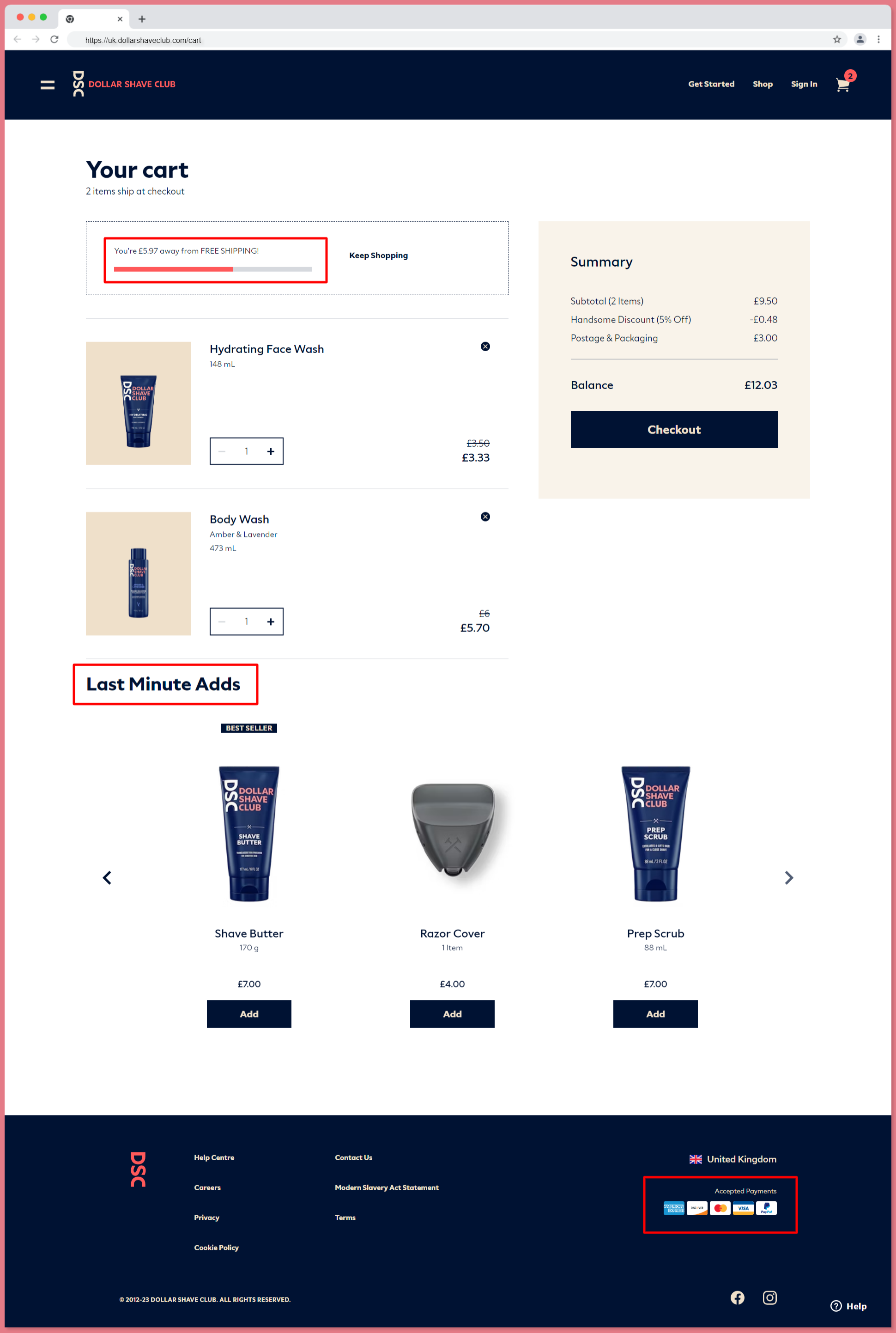
#2 Nordstrom
To reduce cart abandonment, Nordstrom, a high-end department store, implemented a feature that saves customers' cart items across different devices.
This means that if a customer adds items to their cart on their desktop computer, they can still see those items in their cart when they access the Nordstrom website on their mobile device.
This helps to reduce friction in the checkout process and encourages customers to complete their purchases.
By providing a seamless shopping experience across devices, Nordstrom was able to improve customer satisfaction and increase conversions.
Save for later option is visible in the cart to remind the user about the missed products which can hoighly increase the purchase rate.
Mulitple payment options are also available.
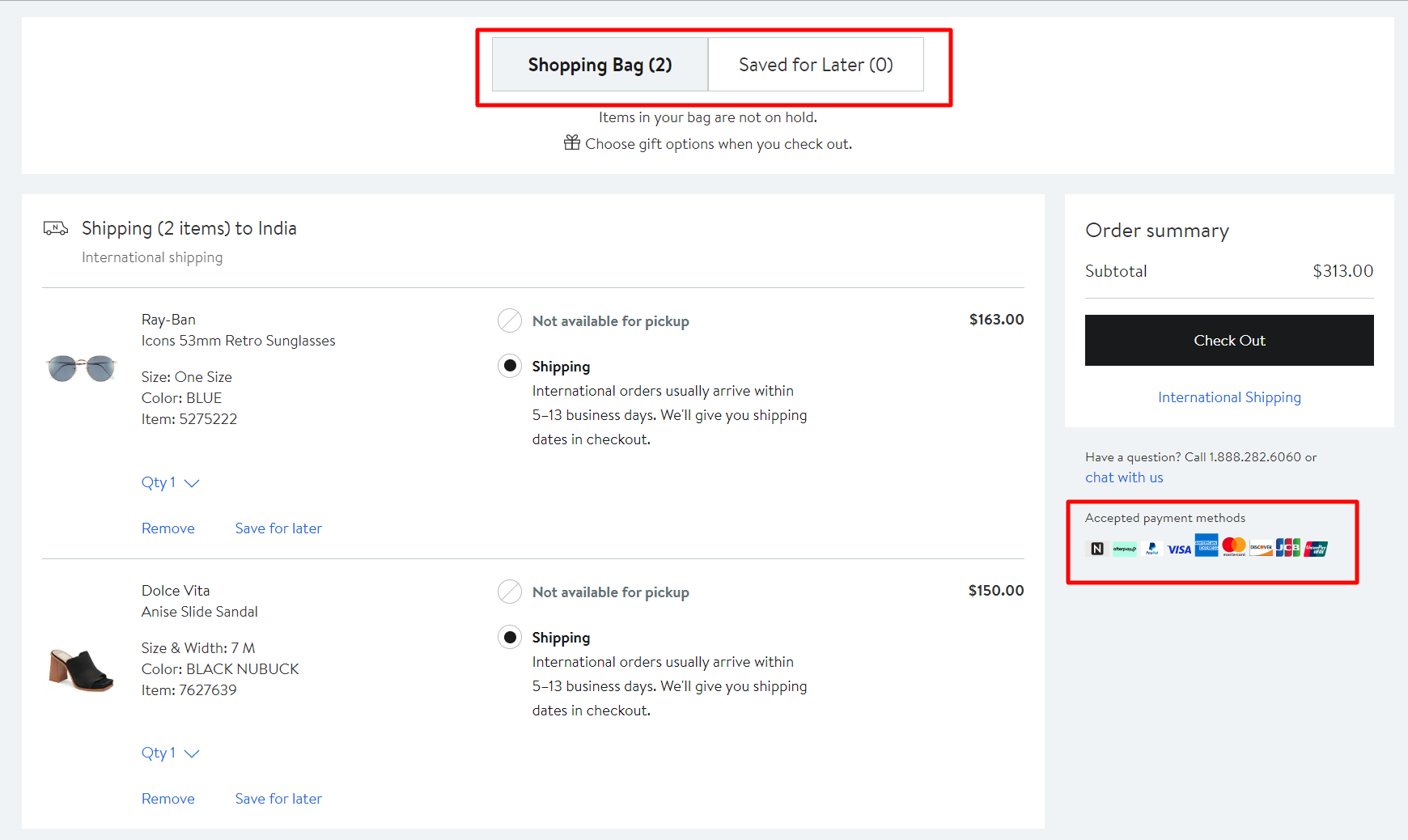
#3 Zenni
Zenni Optical is an online store that specializes in selling prescription glasses and sunglasses.
To reduce cart abandonment, the company implemented a virtual try-on feature that allows customers to upload their photo and try on different frames virtually.
This feature helps customers to visualize how the glasses will look on them and to make a more informed purchase decision.
By addressing the issue of uncertainty about the appearance of the product, Zenni Optical was able to reduce cart abandonment and increase customer satisfaction.

#4 HP
HP, a technology company with a global presence, managed to decrease cart abandonment rates through the implementation of an abandoned cart recovery email campaign.
This involved sending customized emails to customers who had left items in their shopping carts and offering them a discount or incentive to complete the purchase.
By doing so, HP was able to recover potentially lost sales and boost its revenue. This strategy is effective because it directly targets customers who have shown interest in the products but for some reason did not complete the purchase.
The personalization aspect of the email campaign also adds a human touch and can improve customer engagement and loyalty.
#5 Adidas
Adidas, a leading sportswear brand, was able to reduce cart abandonment rates by introducing a feature that allowed customers to view the estimated delivery date and time during the checkout process.
By addressing a common reason for cart abandonment, which is lack of transparency around shipping times, Adidas improved its customers' satisfaction and encouraged them to complete their purchases.
Additionally, Adidas offered free shipping on all orders, which helped to incentivize customers to make purchases without worrying about additional shipping costs.
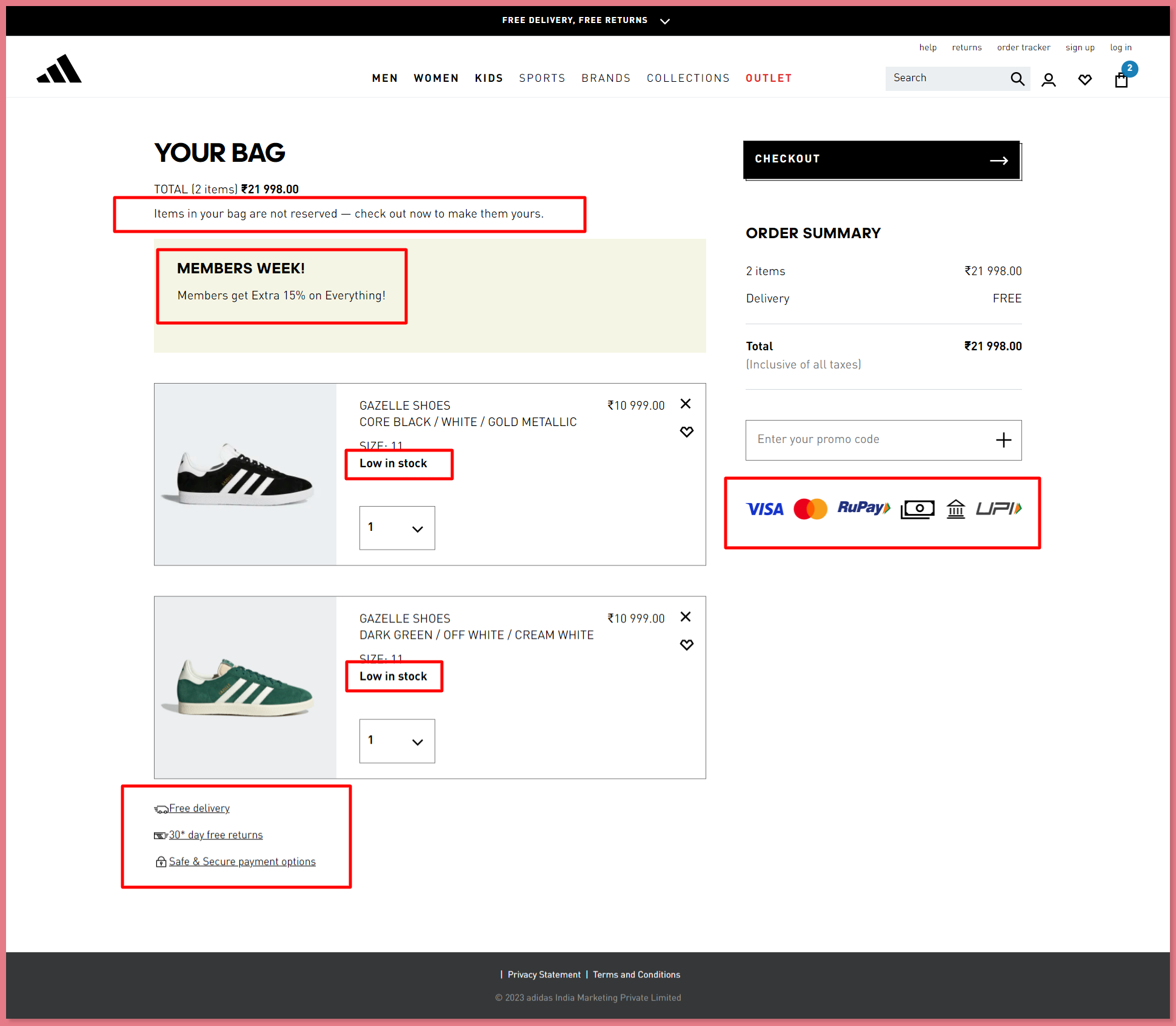
#6 Groupon
Groupon, an e-commerce platform offering discounts on various products and services, has effectively reduced cart abandonment rates by introducing a feature that allows customers to save their cart and receive email reminders when items in their cart are about to expire.
This feature aims to remind customers of their pending purchases, making it more convenient for them to complete their transactions without forgetting their previous orders.
As a result, Groupon has seen an increase in conversions and a decrease in cart abandonment, improving their revenue and customer retention.
#7 Bonobos
Bonobos, a men's clothing retailer, was able to reduce its cart abandonment rate by implementing a live chat feature on its website and allowing customers to buy without any signin and can finish the purchase as guests.
This feature allowed customers to receive real-time assistance with any questions or concerns they may have had during the checkout process.
By providing personalized support, Bonobos improved customer satisfaction, reduced cart abandonment, and increased customer loyalty.
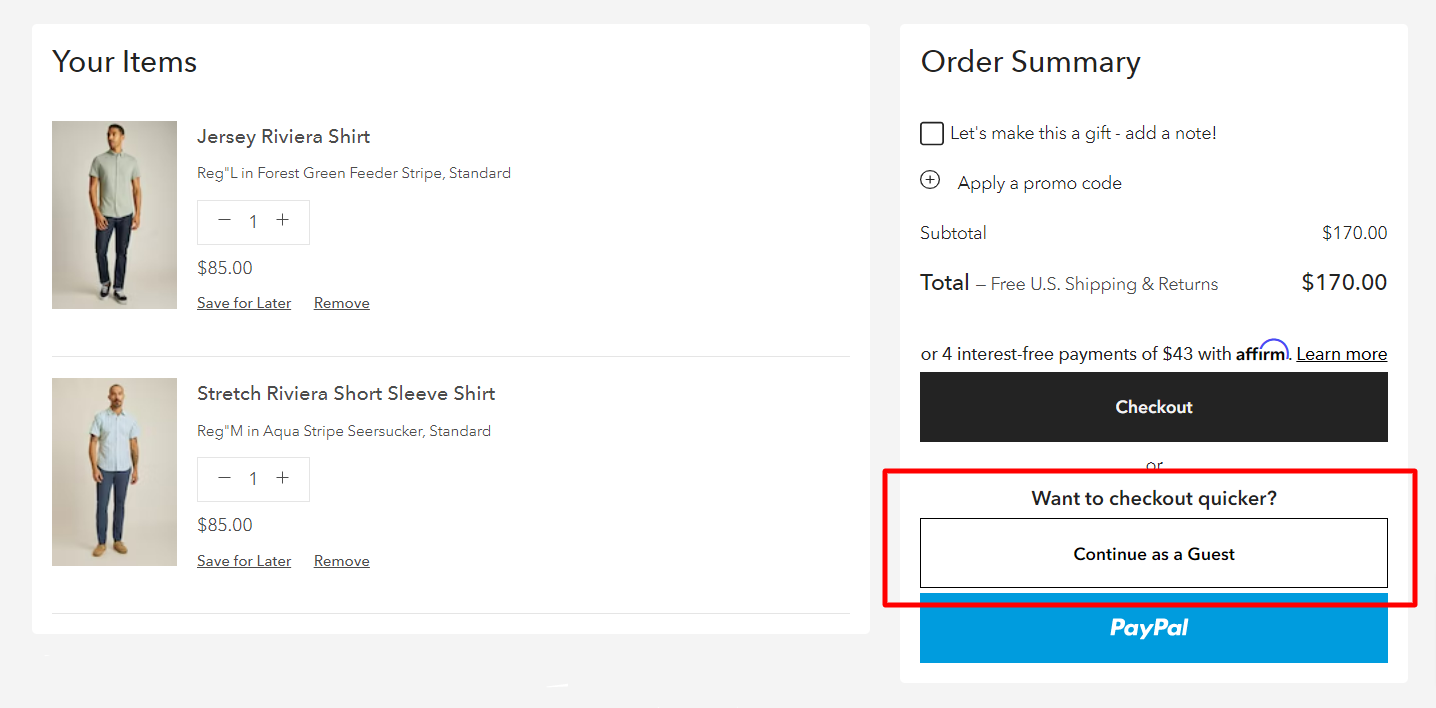
Conclusion:
In conclusion, cart abandonment is a significant challenge faced by businesses operating in the e-commerce industry.
The reasons for cart abandonment can vary from high shipping costs to a complicated checkout process, but the resulting impact on businesses is clear: lost sales and revenue.
To address this issue, businesses can adopt a range of best practices to reduce cart abandonment rates.
Simplifying the checkout process, being transparent about costs, and building trust with customers are key strategies that businesses can adopt to improve their chances of converting potential customers into loyal ones.
ReplayBird - Capture and Understand What Makes Cart Abandonment
ReplayBird is a digital experience analytics platform that offers a comprehensive real-time insights of why your customers abandon your website carts and take actionable steps to reduce cart abandonment rates.
Watch user sessions in real-time, providing valuable insights into user behavior and identifying potential issues in the checkout process and get a complete picture of user behavior from the visiting page to exit page, understand their pain points, and improve the overall end-user experience.
Session replay feature allows you to watch user sessions in real-time, so you can understand their actions, identify issues and quickly take corrective actions such as making improvements to your website's user experience or fixing technical issues that may be hindering conversions.
Error analysis feature helps you identify and resolve javascript errors as they occur, minimizing the negative impact on user experience.
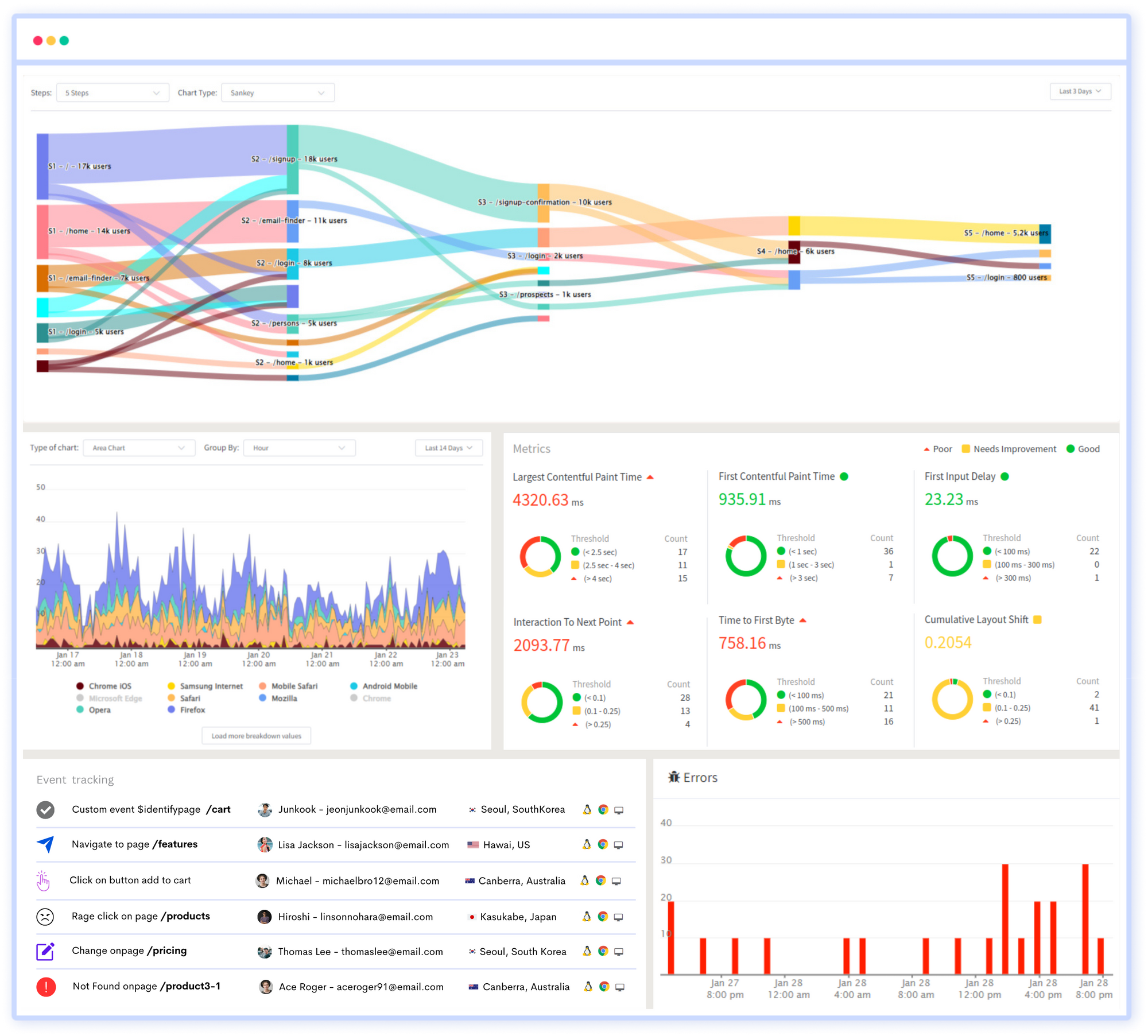
With product analytics feature, you can get deeper insights into how users are interacting with your product and identify opportunities to improve. Drive understanding, action, and trust, leading to improved customer experiences and driving business revenue growth.
Try ReplayBird 14-days free trial
Further Readings:


